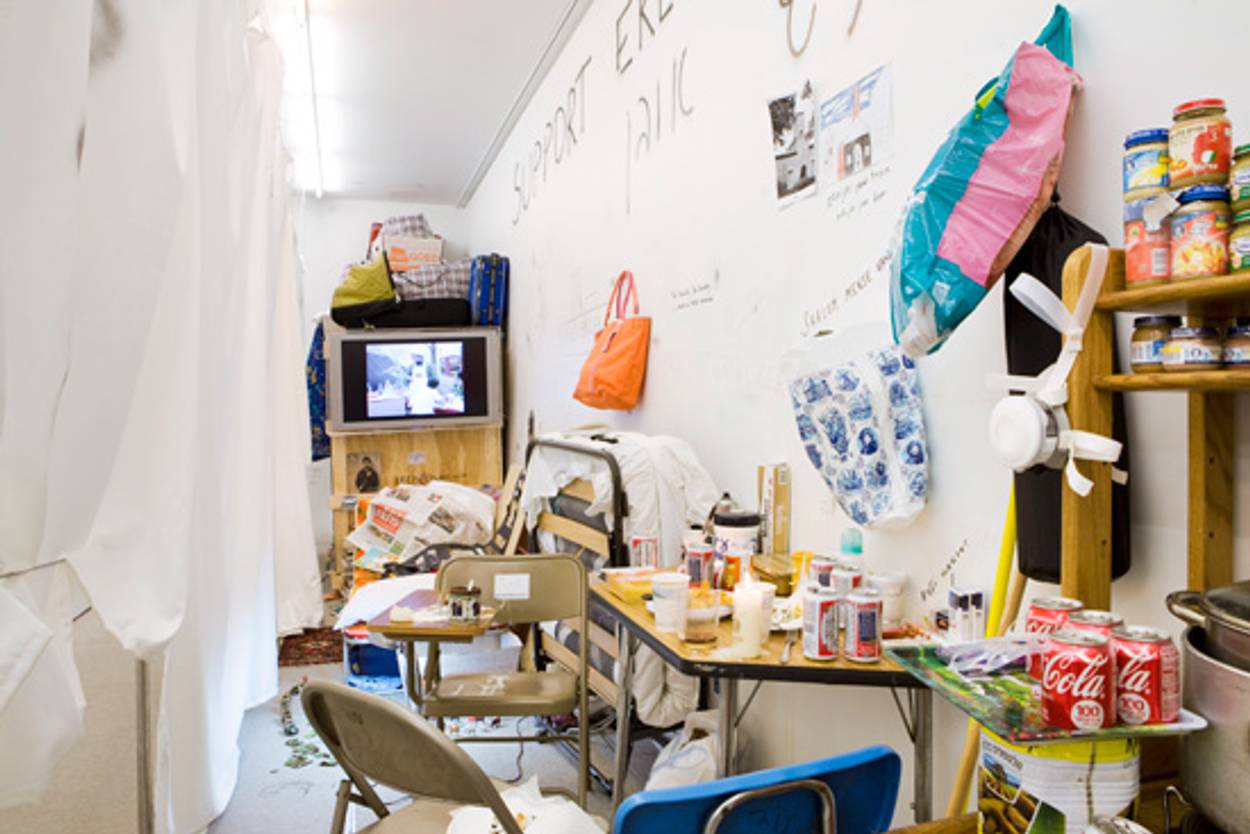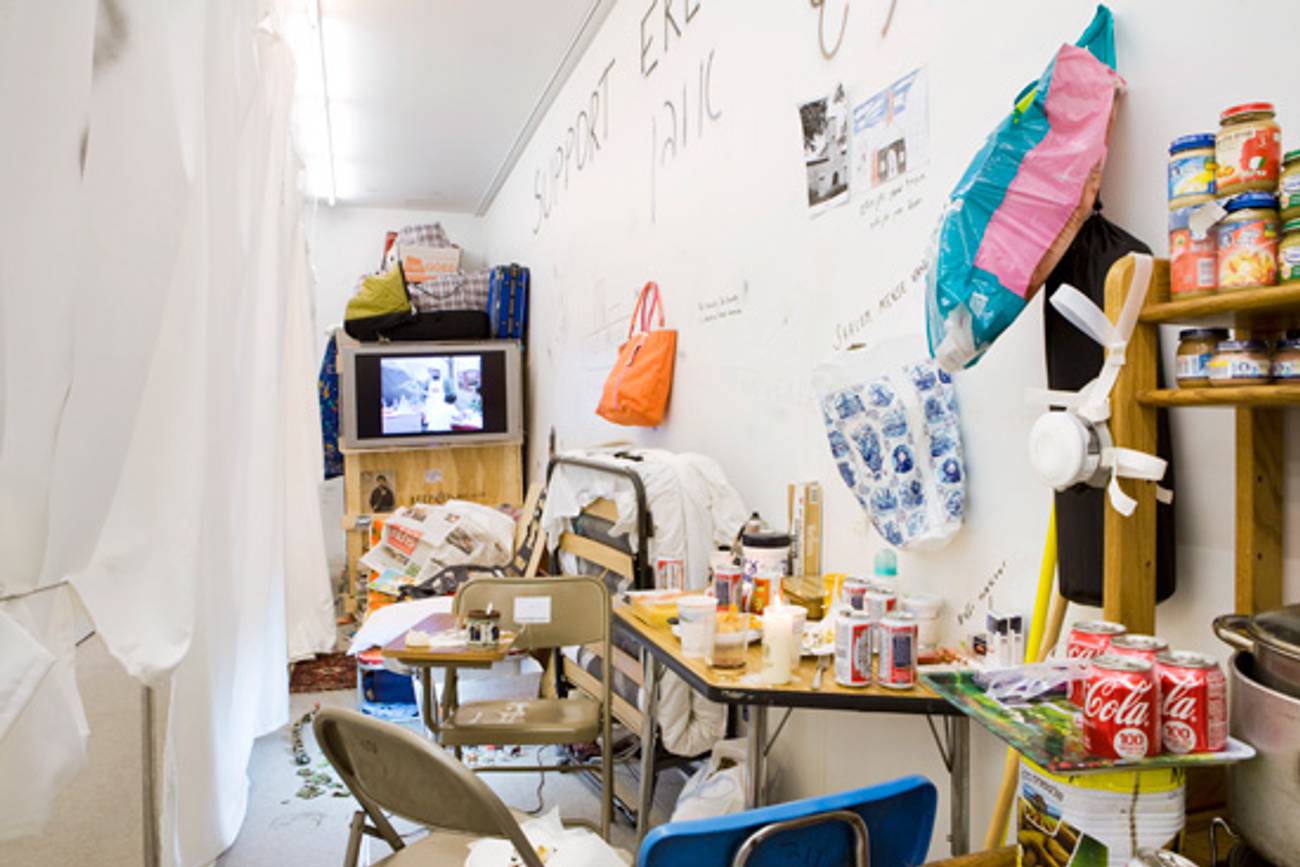Here and There
Notes toward a theory of post-Diasporist art




Diasporist painting, which I just made up, is enacted under peculiar historical and personal freedoms, stresses, dislocation, structure, and momentum. The Diasporist lives and paints in two or more societies at once. Diasporism . . . is as old as the hills (or caves) but new enough to react today’s newspaper or last week’s aesthetic musing or tomorrow’s terror.
So wrote the late, great R.B. Kitaj in his First Diasporist Manifesto (1989), which argued for a Jewish art made radical by virtue of its Jewish content. He may have been traditional in his choice of medium, but in his message he was ahead of his time. Two decades later, Diasporism—African, Indian, Chinese, Palestinian—with all the implications of hybrid identity, history, and politics that Kitaj described, is a predominant theme in the academy, the museum, and the market.
Galutian art, which I just made up, is Jewish, post-Diasporist art. Deriving from the Hebrew Galut, for exile, Galutian art has a lot in common with Kitaj’s Diasporism. But it is Diasporism turned inside out. For while Kitaj was hardly pro-assimilation, he viewed the periphery as the new center, throwing off the tragic sense of loss associated with the Diaspora. Galutian artists, paradoxically, tend to have lived or worked in Israel. Their work reclaims the nostalgic essence of Galut—except that what’s lost is the promise of the Promised Land.
Usually multimedia and high concept, Galutian art is characterized by explorations of disputed territories, border crossings, and the Holy Land as an idea rather than a place. A classic example is Shirley Shor’s Landslide, an animation of a shape-shifting map projected on a sandbox that is intended as a metaphor for territorial conflicts in the Middle East. Owned by the Berkeley Art Museum, it has appeared in several shows with Galutian themes, among them the short-lived “Imaginary Coordinates” at Chicago’s Spertus and “The Hidden Trace: Jewish Paths Through Modernity” at the Felix Nussbaum Haus in Osnabrück, Germany. Indeed, in a fashion unprecedented for Jewish-identified art, Galutian art moves easily between Israeli museums, Jewish museums in the Diaspora, and mainstream museums and galleries, as recent shows of Sigalit Landau, Michal Rovner, and Yael Bartana attest.
The fashion house Hermès helped produce Bartana’s unsettling film Mary Koszmary (Nightmares), which screened in several European venues, including the Pompidou Centre, before its opening at New York’s Jewish Museum. Set in a desolate Warsaw stadium, the film shows a Polish leader passionately beseeching 3 million Jews to return their homeland and chase away its demons. Lampooning anti-Semitism, philo-Semitism, and Zionism in one fell swoop, the satire is so on point that several viewers told the artist they thought it was real.
This rather abject re-staging of a Galut for the modern era is hardly what Kitaj had in mind, but that seems to be the latest trend. Ronen Eidelman, an Israeli living in Germany, has attracted considerable attention with Medinat Weimar, his proposal to create a Jewish state in Thuringia. Promising to “heal Jewish trauma” even as it addresses the failures of Zionism, Medinat Weimar has already staged a rally and conference and created its own Unternationale anthem. Meanwhile, Amit Epstein, a Tel Aviv-born, Berlin-based artist, has announced a proposal for Bundesland Israel, a project to create “an Israel away from Israel”—in Germany. Starting with pointed questions about Zionist ideals, Israel’s image in Europe, and how the removal of Israel from the Middle East would affect world peace, the project culminates with a performance in which the cornerstone is formally placed.
A more visceral artistic re-imagining of the Galut just materialized at New York’s New Museum. Exodus 2048 was created by Michael Blum, a Jerusalem-born artist based in Vienna and New York. The text panels tell the story he has conjured, of 4,500 Jews wandering the seas on a ship named Exodus. But instead of trying to enter Israel, they’re escaping, because of a rumored Palestinian takeover. With the Israeli government exiled in Brooklyn, 113 refugees have found sanctuary in Holland—specifically, in the clocktower of Eindhoven’s Van Abbemuseum, in a makeshift camp where they await word of their fate.
Unsettling and mesmerizing, Blum’s installation brings the shelter to life—a jumble of cots, cribs, baby food, beer cans, and Israeli flags (doubling as pillowcases)—punctuated by agitated graffiti infused with apprehension and nostalgia. Talk about, as Kitaj put it, tomorrow’s terror today. After all, Kitaj was obsessed with zeroing in on dark places in a possible near future.
Kitaj always thought his art-world success was thwarted by anti-Semitic critics uncomfortable with his explicit Jewish content. The conspicuous ambivalence of Galutian art, in contrast, has some Jewish leaders expressing concerns that it might foster anti-Semitism. Of course this very ambivalence is what seems to have deactivated the “too Jewish” prejudice often afflicting the contemporary art world. It’s sad that things had to get this bad for Jewish art to become so relevant.
Robin Cembalest is executive editor of Artnews.
Robin Cembalest is executive editor of ARTnews. She blogs at letmypeopleshow.com. Her Twitter feed is @rcembalest.
Robin Cembalest is executive editor ofARTnews. She blogs at letmypeopleshow.com. Her Twitter feed is @rcembalest.